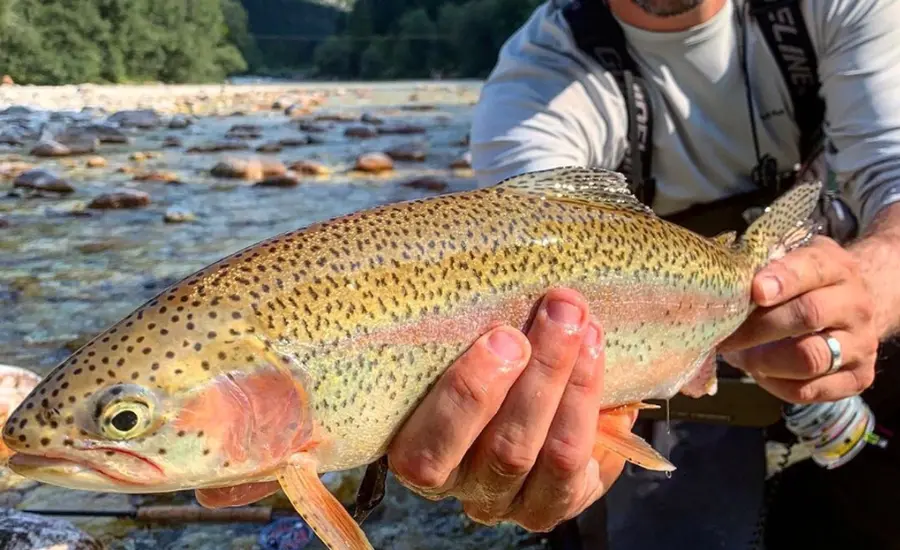The Rainbow trout (Oncorhynchus mykiss) is a trout and species of salmonid native to cold-water tributaries of the Pacific Ocean in Asia and North America. Resident freshwater rainbow trout adults average between 1 and 5 lb (0.5 and 2.3 kg) in riverine environments, while lake-dwelling and anadromous forms may reach 20 lb (9 kg). Coloration varies widely between regions and subspecies. Adult freshwater forms are generally blue-green or olive green with heavy black spotting over the length of the body. Adult fish have a broad reddish stripe along the lateral line, from gills to the tail, which is most pronounced in breeding males. The caudal fin is squarish and only mildly forked. The maximum recorded lifespan for a rainbow trout is 11 years. Freshwater resident rainbow trout usually inhabit and spawn in small to moderately large, well oxy-genated, shallow rivers with gravel bottoms. They are native to the alluvial or freestone streams that are typical tributaries of the Pacific basin, but introduced rainbow trout have established wild, self-sustaining populations in other river types. Lake resident rainbow trout are usually found in moderate-ly deep, cool lakes with adequate shallows and vegetation to support production of sufficient food sources. Rainbow trout are predators with a varied diet and will eat nearly anything they can capture. They are not as piscivorous or aggressive as brown trout or chars. Rainbow trout, including juvenile steelhead in fresh water, routinely feed on larval, pupal and adult forms of aquatic insects (typically caddisflies, stoneflies, mayflies and aquatic diptera). They also eat fish eggs and adult forms of terrestrial insects (typically ants, beetles, grasshoppers and crickets) that fall into the water. Other prey include small fish up to one-third of their length, crayfish, shrimp, and other crustaceans.
Brown trout can live 20 years, but as with the Atlantic salmon, a high proportion of males die after spawning. Brown trout are active both by day and by night and are opportunistic feeders. While in fresh water, their diets frequently include invertebrates from the streambed, other fish, frogs, mice, birds, and insects flying near the water’s surface. The high dietary reliance upon in-sect larvae, pupae, nymphs, and adults allows trout to be a favoured target for fly fishing. Sea trout are fished for especially at night using wet flies. Freshwater brown trout range in colour from largely silver with relatively few spots and a white belly, to the more well-known brassy brown cast fading to creamy white on the fish’s belly, with medium-sized spots surrounded by lighter halos. The more silver forms can be mistaken for rainbow trout. The continental European strain features a lighter golden cast with some red spotting and fewer dark spots. Brown trout rarely form hybrids with other species; if they do, they are almost invariably infertile. One such example is the tiger trout, a hybrid with the brook trout.


